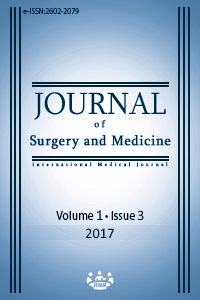Comparison of open acromioplasty outcomes according to approach type; anterior and lateral
Keywords:
Subacromial impingement syndrome, acromioplasty, acromionAbstract
Aim: Subacromial impingement syndrome appears to be one of the most frequent causes of shoulder pain. Acromioplasty is the surgical intervention modality where conservative treatment no longer gives effect. Even though arthroscopic techniques keep arising popularity, open acromioplasty yet is very often used surgery. Our main goal was to compare clinical success of anterior and lateral open techniques whether or not these techniques affect final range of motion, DASH , UCLA & CONSTANT scores
Methods: We assembled 37 regularly followed cases (26 female, 11 male ) over 18 years old, operated between 2014-2016. We then ultimately evaluated comparison among variations such as age, sex, dominant extremity, postoperative follow-up time, approach type, operation duration, acromion type and most recent form where CONSTANT, DASH and UCLA scores , ROM(range of motion) , developed complications were assessed. We divided cases to 2 main groups ; group1 anterior approach and group 2 lateral approach. Comparison throughout this particular study mainly went on these 2 groups.
Results: 70.3% (26 cases ) were female , 29.7% (11 cases) were male. Mean age was 57.64 ± 9.17 (avg 45-84years) . 75.6 % (28 cases ) had symptoms on dominant limb. Postoperative mean follow-up 18,49±5.37 months (avg 8-28 months). Mean operation duration was 35 minutes for group 1 and 37 minutes for group 2. No complications were presented. Patients also filled out prepared subjective survey papers at final clinical examination. Mean CONSTANT score was 88.5 for group1 and 83.57 for group 2. Postoperative recovery lasted upon 7.1 ± 3.3 weeks (avg 1-12 week) and 6.6 ± 3.9 weeks (avg 1-14 wk) in group 2. CONSTANT, UCLA and DASH scores were evaluated separately and showed no significant difference in ordinary comparison, whereas very same CONSTANT scores were put to odds ratio calculator and presented surprising result ; according to preoperative-postoperative comparison, anterior approach was predicted that would have had 2.8 times chance to show better results( 80< score) than lateral approach. Same ordinary comparison was performed on UCLA and DASH scores and no significant difference was detected. Although very same odds ratio calculation for UCLA scores appeared to be 2.5 and for DASH it was 1.167. In all three assessment methods anterior approach was more recommendable approach type. Subjective assesments of the patients were as following: 14 patients determined clinically very good and good , 1 patient normal in group 1 , where 16 patients were determined very good amd good , 2 normal and 3 patients poor according to overall scoring .
Conclusion: There is no significant difference between anterior and lateral approaches according to ROM, various scorings, hospitalization duration. On the other hand, for subacromial impingement, open acromioplasty is yet highly reliable, convenient method with short surgery time.
Downloads
References
Neer CS 2nd. Anterior acromioplasty for the chronic impingement syndrome in the shoulder: a preliminary report. J Bone Joint Surg [Am] 1972;54:41-50.
Neer CS 2nd. Impingement lesions. Clin Orthop 1983;(173):70- 7.
Chipchase LS, O'Connor DA, Costi JJ, Krishnan J. Shoulder impingement syndrome: preoperative health status. J Shoulder Elbow Surg 2000;9:12-15.
Bigliani LU, Morrison D, April EW: The morphology of the acromion and relationship to the rotator cuff tears. Orthop Trans 10:228, 1986.
Chin PY, Sperling JW, Cofield RH, Stuart MJ, Crownhart BS. Anterior acromioplasty for the shoulder impingement syndrome: long-term outcome. J Shoulder Elbow Surg 2007; 16: 697-700.
Matsen FA 3rd, Arnts CT. Subacromial impingement. In: Rockwood CA, Matsen FA 3rd, (Editors). The shoulder. Vol. 2, 2nd ed. Philadelphia: W. B. Saunders; 1998: 623-646.
Bezer M, Aydin N, Erol B, Kocaoğlu B, Güven O. Late results of arthroscopic and open anterior acromioplasty. Acta Orthop Traumatol Turc 2004; 38:115-119.
Altchek DW, Warren RF, Wickiewicz TL, Skyhar MJ, Ortiz G, Schwartz E. Arthroscopic acromioplasty. Technique and results. J Bone Joint Surg [Am] 1990; 72:1198-1207.
Lindh M, Norlin R. Arthroscopic subacromial decompression versus open acromioplasty. A two-year follow-up study. Clin Orthop 1993;290:174-176.
Valenti P. Arthroscopic subacromial decompression. Chir Main 2006; 25 Suppl 1:22-28.
Barfield LC, Kuhn JE. Arthroscopic versus open acromioplasty: a systematic review. Clin Orthop Relat Res 2007;455:64-71.
Spangehl MJ, Hawkins RH, McCormack RG, Loomer RL. Arthroscopic versus open acromioplasty: a prospective, randomized, blinded study. J Shoulder Elbow Surg 2002;11:101-107.
Rockwood CA, Lyons FR. Shoulder impingement syndrome: diagnosis, radiographic evaluation, and treatment with a modified Neer acromioplasty. J Bone Joint Surg [Am] 1993;75:409-424.
Checroun AJ, Dennis MG, Zuckerman JD. Open versus arthroscopic decompression for subacromial impingement. A comprehensive review of the literature from the last 25 years. Bull Hosp Jt Dis 1998;57:145-151.
Ertan S, Ayhan E, Güven MF, Kesmezacar H, Akgün K, Babacan M. Medium term natural history of subacromial impingment syndrome. J Shoulder Elbow Surg. 2015 Oct;24(10):1512-8. doi: 10.1016/j.jse.2015.06.007. Epub 2015 Jul 23.
Ellman H. Arthroscopic subacromial decompression: analysis of one- to three-year results. Arthroscopy 1987;3:173-81.
Downloads
- 2920 2878
Published
Issue
Section
How to Cite
License
Copyright (c) 2017 Kemal Kayaokay, Cevad Mirzazade, Levent Küçük, Erhan Coşkunol
This work is licensed under a Creative Commons Attribution-NonCommercial-NoDerivatives 4.0 International License.















